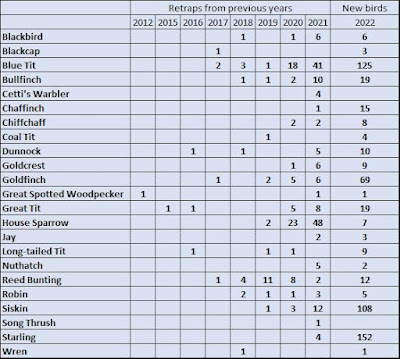The 1st of April brought the start date for the second year of my House Sparrow RAS. With a good number of birds colour ringed in 2021, I successfully logged 35 different birds on the first morning for this year while having breakfast. Further observations over mid morning coffee took me up to 50 different birds and two further sessions on the 2nd of April took me up to 67 different individuals (40 male, 27 female).
Despite my best effort last year, a reasonable number of 'older' birds still only have metal rings only and probably a similar number have no ring at all. The ideal situation would be to try to ring these birds but putting up mist nets in less than perfect conditions will mean high disturbance for low return as the birds will see the nets and simply avoid the garden. Walk in traps don't get used by adult birds in my garden so my best option is to focus on reading as many colour rings as possible while many birds are still coming to seed.
N68 is a female that was ringed on the 22nd of February 2021. Being ringed in February, all that can be said about her is that she is from the 2020 breeding season or before.
40 of the birds sighted so far can be identified to a specific breeding season with the remaining being as N68. 33 of the birds sighted are over a year old. The majority of the remaining birds are known to be from the 2021 breeding season so technically speaking they are birds that have simply survived their first winter; many will of course breed this year. The oldest bird is known to be from the 2016 breeding season or before. Over time it should be possible to increase the proportion of specifically aged birds.
At this stage of the season many pairs in the garden are still in the process of nest building while adult birds that have lost their mate are trying to pair up or find a different nesting site. P05 (male from 2018 or earlier) seems to have lost his mate N90 (female from 2018 or earlier) and has moved to a new site. The box that he is clearing out was initially used by N01 (male) and N25 (female) last year and then by an unknown male and N25 for a later brood. Both N01 and N25 have not been seen for some time and the unknown male could not have been P05 so he may also have disappeared. Last year I noted that most of the early nesting attempts were made by incumbent adults with the offspring from the previous season mainly pairing and making nesting attempts later in the year.
.JPG)
The above female is not ringed. Most females have a bill colour that is dark brown containing varying amounts of dark buff-yellow/brown towards the base and in the lower mandible. This particular bird stands out amongst other females having a bill colour that is similar to a breeding season male.







.JPG)
.JPG)